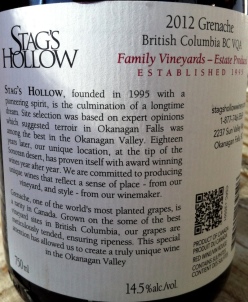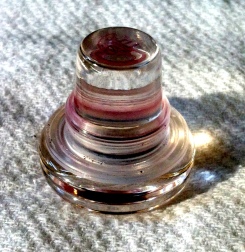[This bottle was provided as a sample for review purposes.]
I will spare you the details of why I haven’t posted in awhile; suffice to say that it involves multiple children under the age of 3, potty training, vomit, and the inexorable loss of sanity. As a result of the above, these first 50 words have taken 25 minutes to write. But I will not be deterred, because today is something bigger than you or I or the trials of parenting. Today is International Grenache Day. And today I get to write about a wine that I have followed from a distance for a long time, even though it is brand new to market.
I have recently come to realize and embrace that, when it comes to reds, I’m a Rhone guy. I have adored Syrah for quite some time, but in the last few months I have become increasingly enamored with the southern French region’s other red offerings as well. I tried with piqued curiosity my first varietal Carignan, the ’70s shag carpet of wine. I devoured Mourvedres from Bandol to Washington State and back. And I opened my heart to the joy and beauty of Grenache. There may be other grapes that I enjoy more at their peak expressions, but I don’t know if there’s another grape out there that disappoints as seldom as Grenache does. No matter how much it costs or where it’s from, it always hits the mark and is reliably bright and juicy and enjoyable.
But what it’s not, at least until now, is from Canada. Grenache is generally a hot-climate grape, one that needs a lot of sun and a lot of warmth to ripen. It’s best known in the Mediterranean climates of southern France and the arid deserts of Spain, occasionally popping up in the equally balmy South Australia or the equally parched eastern Washington. In Canada, where every grape imaginable seems to be planted with hope somewhere, I had never heard of Grenache being grown, and certainly had never seen it being bottled on its own, until I happened to stumble on a Twitter mention of this project by Stag’s Hollow winemaker Dwight Sick. I have been thoroughly intrigued by the idea of Okanagan Grenache ever since, and after some relentless cyber-stalking, I was lucky enough to snag a bottle of this inaugural experiment and see for myself how this warm weather red adapted to my home and native land.
So how do you get a hot-climate red to ripen at the world’s northern limit for viticulture? I asked Sick that exact question:
In other words, ripe Canadian Grenache doesn’t come easy and requires a ton of work, as well as some significant cooperation from Mother Nature. This is a labour of patience and love: Sick first planted Grenache at the Kiln House Vineyard near Penticton in 2006 and has been waiting to make this wine ever since. This 2012 combines the Kiln House grapes with other Grenache planted slightly further southwest in the Blind Creek Vineyard in the Similkameen Valley. The grapes were hand-picked, hand-sorted and carefully fermented and aged in neutral French oak. The result is, as far as I can tell, Canadian history.
 “Transparent” is the word I kept coming back to when drinking this wine. It was a bright, translucent ruby-purple colour, clear and totally see-through right to the core — nowhere to hide. Wild raspberry and candied cherry fruit danced with tangy rhubarb, brown sugar and poultry herbs (sage, rosemary) on the open, playful nose, and from the first instant the wine hit my tongue it hummed with energy. It was sleek and medium-bodied but was shimmering and pulsing with life, delicate yet powerful, classic Grenache. Pure and open flavours of brambly red fruit, violets, savoury spices combined with a jolt of citrus/pomegranate that offered some bite, smooth gentle tannins that stayed well in the background, and a hint of eucalyptus on the back end. The alcohol is 14.5% but I didn’t notice it at all, even on the wine’s lightweight, almost ethereal frame. The buoyant and ripe fruit floated on the palate and yet lingered long after I swallowed, with a finish eerily reminiscent of cherry Life Savers (in the best possible connotation of this flavour). This is the Oregon Pinot Noir of Grenache: delicate, pure, unforced, nuanced, and yes, transparent.
“Transparent” is the word I kept coming back to when drinking this wine. It was a bright, translucent ruby-purple colour, clear and totally see-through right to the core — nowhere to hide. Wild raspberry and candied cherry fruit danced with tangy rhubarb, brown sugar and poultry herbs (sage, rosemary) on the open, playful nose, and from the first instant the wine hit my tongue it hummed with energy. It was sleek and medium-bodied but was shimmering and pulsing with life, delicate yet powerful, classic Grenache. Pure and open flavours of brambly red fruit, violets, savoury spices combined with a jolt of citrus/pomegranate that offered some bite, smooth gentle tannins that stayed well in the background, and a hint of eucalyptus on the back end. The alcohol is 14.5% but I didn’t notice it at all, even on the wine’s lightweight, almost ethereal frame. The buoyant and ripe fruit floated on the palate and yet lingered long after I swallowed, with a finish eerily reminiscent of cherry Life Savers (in the best possible connotation of this flavour). This is the Oregon Pinot Noir of Grenache: delicate, pure, unforced, nuanced, and yes, transparent.

Cork Review: Cool!/10 (Normally I would frown on faux corks, but this glass Vino-Lok enclosure is both chic and ultra-effective. These were all inserted into the bottles by hand!!)
It is absolutely eye-opening that this kind of wine is possible in Canada. We’re a country (and the Okanagan is a region) that is still trying to forge a wine identity, and experimentation of this sort which stretches our boundaries and defies standard conventions (we’re too young a wine nation to have conventions!) will help us get there. I would be very curious to see how this Grenache ages: the winery suggests that it should remain eminently drinkable for years to come, but it also strikes me as a bottle that’s singing right now and primed for enjoyment in the near future. I will just have to get some more and find out, though with a 170-case production, Stag’s Hollow is sure to sell out of the country’s first bottles of varietal Grenache fast. If you live in my neck of the woods in Alberta and are hoping to snag a bottle, your best bet may be to order online direct from the winery here. I might just split an order with you.
90+ points
$30 CDN (cellar door price at the winery)



Good to see you back!
LikeLike
Thanks Oliver! I hope to be a little more consistent going forward in my writing, but we shall see. I enjoyed your recent post about Possession in the wine world (and didn’t know that you were a lawyer as well!) — I think about that idea a lot because I tend to (over?)emphasize the importance of wineries doing it all: owning the land, growing/tending the fruit, making the wine. Great read.
LikeLike
Well, we all know how life can get in the way at times…hope to see you around more for sure!
Thanks for the comment. Being a lawyer is a two-edged sword, right? Good training but sometimes makes one think in weird ways.
There is just something very alluring about the idea of a winemaker having control over everything. It is still true for many German winemakers. But I am watching wineries that are trying to grow in their basic segment and think about buying grapes from other growers in the area. They naturally worry about the quality of the grapes etc, so they want to make detailed contracts and need deep trust in the people they buy from. Compromising their reputation is dangerous. It is a tough weighing of options, but if you know you could sell 60,000 bottles of your Gutsriesling when you can only produce 30,000 from your own vineyards, that question becomes virulent.
LikeLike
Stag’s Hollow makes an awesome Tempranillo as well, they’ve just released Cachet #3.
LikeLike
I’ve tried Cachet #1 before (it’s a Tempranillo-based blend) — https://popandpour.ca/2013/02/27/wine-review-2008-cachet-no-01-by-stags-hollow/. I quite liked it but thought it tasted a bit like it could have come from anywhere. I’ve been told by multiple people that the Cachet #3 really steps up the Tempranillo game, but I haven’t tracked down a bottle yet. Cheers!
LikeLike